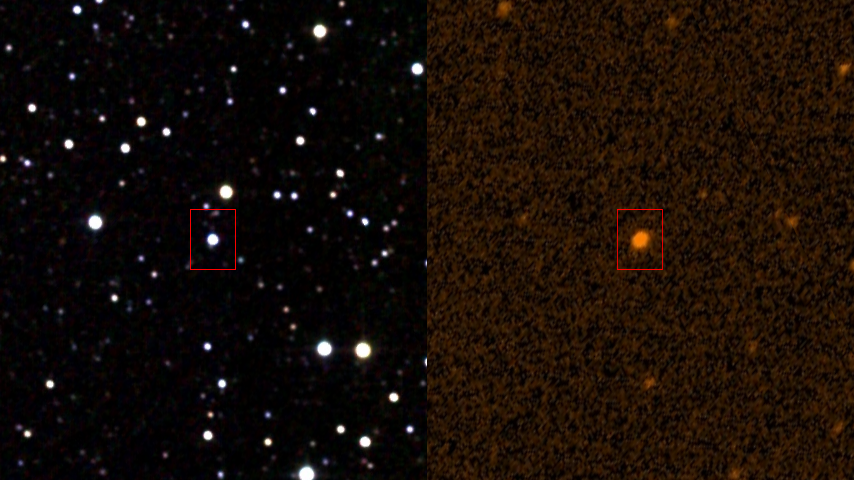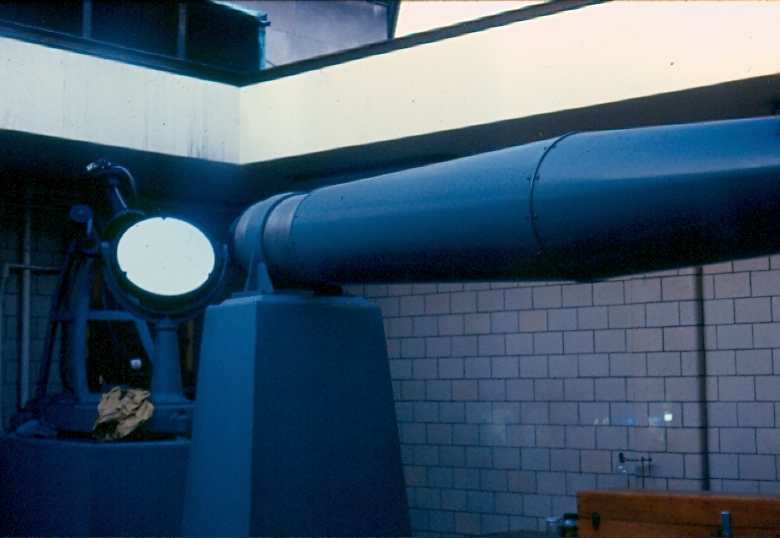
Two photographs of Star KIC 8462852; first in infrared, and the second one in ultraviolet.
(Image Sources: Wikipedia.org , "KIC 8462852 in IR and UV" by Infrared: IPAC/NASAUltraviolet: STScI (NASA) - http://aladin.u-strasbg.fr/AladinLite/?target=TYC%203162-665-1&fov=0.27&survey=P%2F2MASS%2Fcolor and http://aladin.u-strasbg.fr/AladinLite/?target=TYC%203162-665-1&fov=0.27&survey=P%2FGALEXGR6%2FAIS%2Fcolor. Licensed under Public Domain via Commons - https://commons.wikimedia.org/wiki/File:KIC_8462852_in_IR_and_UV.png#/media/File:KIC_8462852_in_IR_and_UV.png )
By Glenn A. Walsh
Reporting for SpaceWatchtower
Since late September, there has been
speculation that an alien-built “mega-structure” may explain
unusual fluctuations in light from Star KIC 8462852. Now, a new study
seems to disprove another major explanation for these light
fluctuations: comet fragments.
The Star KIC 8462852 is an F-type main
sequence star, located in the Constellation Cygnus the Swan. Though
this star has been observed for more than a century, recent
observations by NASA's Kepler Space Telescope have found peculiar light
fluctuations in 2011 and 2013, not seen with any other star.
The Kepler Space Telescope uses the dimming of stars to find extra-solar planets that may be orbiting those stars. However, the unusual dimming of Star KIC 8462852 was not compatible with the dimming usually found when an exo-planet blocks some of the star's light
On October 19, the SETI (Search for
Extraterrestrial Intelligence) Institute announced that they would
start looking for extraterrestrial infrastructure surrounding Star
KIC 8462852. Their interest peaked by the unusual light fluctuations of this particular star. Thus far, the SETI Institute has found no
intelligent radio signals from this star..
The speculation regarding a possible
alien-built “mega-structure” has been one explanation for the
unusual light dimming with this star. It has been proposed that such
a “mega-structure” could be a “Dyson Sphere” or “Dyson
Swarm,” which would be artificial structures that surround a star
in order to collect most or all of the star's solar energy. It is
suggested that an advanced civilization would need to build such a
“mega-structure,” to meet the increasing energy needs of their
growing society. Finding, and confirming the existence
of, such a “mega-structure” could be a confirmation that an
advanced civilization resides near this star.
In an October 23 interview with the
radio program, “Essential Pittsburgh” on Pittsburgh's WESA-FM
90.5, Point Park University Professor and Astrophysicist Brendan
Mullan (formerly Director of the Henry Buhl, Jr. Planetarium and
Observatory at Pittsburgh's Carnegie Science Center) said “It’s
probably not gonna be a mega-structure. It’s more likely something
natural that the universe is throwing at us just to say ‘Hey, I’m
a crazy universe, there’s new stuff out there every day.’”
One of the natural explanations
hypothesized for this unusual dimming was a family of comets with a
long, eccentric orbit around the star. This hypothesis was supported
in a November 24 news release from NASA.
Now, a new study by Bradley E.
Schaefer, Professor of Astronomy and Astrophysics at Louisiana State
University, greatly questions the comet hypothesis. According to this
new study, more than a century of observations of this star seem to
indicate that comet fragments cannot explain the unusual dimming of
the star, as viewed from Earth.
Professor Schaefer reviewed archival
photographic plates, from 1890 to 1989, containing this star, at
Harvard University. He found that the light coming from Star KIC
8462852 had consistent and noticeable dimming for at least a century.
In the abstract of his professional
paper (submitted to Astrophysical Journal Letters), published
on Cornell University Library's pre-print Internet web site
“http://arxiv.org,” Professor Schaefer states, “This
century-long dimming is completely unprecedented for any F-type main
sequence star. So the Harvard light curve provides the first
confirmation that KIC 8462852 has anything unusual going on.”
He goes on to say, “Within the
context of the comet-family idea, the century-long dimming trend
requires an estimated 648,000 giant comets (each with 200 km
diameter) all orchestrated to pass in front of the star within the
last century. I do not see how it is possible for something like
648,000 giant comets to exist around one star, nor to have their
orbits orchestrated so as to all pass in front of the star within the
last century. So I take this century-long dimming as a strong
argument against the comet-family hypothesis to explain the Kepler
dips.”
Massimo Marengo of Iowa State
University has now suggested that the next-best explanation may be
that Star KIC 8462852 has a ring around it, as do four planets in our
solar system (Jupiter, Saturn, Uranus, and Neptune). He notes that
other stars, such as Fomalhaut, do have such rings.
In the October radio interview,
Professor Mullan said, “As an astronomer, [aliens] is the last
explanation you should be seeking when you see something anomalous
like this star.” He added that the existence of an alien-built
“mega-structure” could, still, not be entirely ruled-out: “It’s
probably not aliens but he, who knows? Might be fun.”
More on Star KIC 8462852: Link >>> https://en.wikipedia.org/wiki/KIC_8462852
Professor Schaefer's pre-print abstract: Link >>> http://arxiv.org/abs/1601.03256
More on a Dyson Sphere: Link >>> https://en.wikipedia.org/wiki/Dyson_sphere
More on a Dyson Swarm: Link >>> https://en.wikipedia.org/wiki/Dyson_sphere#Dyson_swarm
Professor Mullan's Radio Interview:
Link >>> http://wesa.fm/post/anybody-out-there-astrophysicists-turn-attention-potential-megastructure-space
Source: Glenn A. Walsh Reporting for SpaceWatchtower, a project of Friends of the Zeiss.
2016 January 19.

2016: 75th Year of Pittsburgh's Buhl Planetarium Observatory
Link >>> http://buhlplanetarium2.tripod.com
Want to receive SpaceWatchtower blog posts in your inbox ?
Send request to < spacewatchtower@planetarium.cc >..
gaw
Glenn A. Walsh, Project Director,
Friends of the Zeiss < http://buhlplanetarium.tripod.com/fotz/ >
Electronic Mail - < gawalsh@planetarium.cc >
SpaceWatchtower Blog: < http://spacewatchtower.blogspot.com/ >
Also see: South Hills Backyard Astronomers Blog: < http://shbastronomers.blogspot.com/ >
Barnestormin: Writing, Essays, Pgh. News, & More: < http://www.barnestormin.blogspot.com/ >
About the SpaceWatchtower Editor / Author: < http://buhlplanetarium2.tripod.com/weblog/spacewatchtower/gaw/ >
SPACE & SCIENCE NEWS, ASTRONOMICAL CALENDAR:
< http://buhlplanetarium.tripod.
Twitter: < https://twitter.com/spacewatchtower >
Facebook: < http://www.facebook.com/pages/
Author of History Web Sites on the Internet --
* Buhl Planetarium, Pittsburgh:
< http://www.planetarium.
* Adler Planetarium, Chicago:
< http://adlerplanetarium.
* Astronomer, Educator, Optician John A. Brashear:
< http://johnbrashear.tripod.com >
* Andrew Carnegie & Carnegie Libraries:
< http://www.andrewcarnegie.
* Civil War Museum of Andrew Carnegie Free Library:
< http://garespypost.tripod.com >
* Duquesne Incline cable-car railway, Pittsburgh:
< http://inclinedplane.tripod.
* Public Transit:
< http://andrewcarnegie2.tripod.
This comment has been removed by a blog administrator.
ReplyDelete